Human Flower Project
Art & Media
Wednesday, July 11, 2012
Mandorla: Intersecting Worlds
With a tragedy in Russia, mourners and their florists turn to an old figure of Eastern Orthodox iconography, shaped like a seed.

A Russian Orthodox priest blesses graves outside Krymsk.
Overnight floods in Krymsk, a southern Russia city east of the Black Sea, killed at least 172 people early Sunday morning. There had been no warning, even though authorities later admitted having known by 10 p.m. Saturday that heavy rains threatened to inundate the town.
Some of the survivors (more than 25,000 lost their homes and belongings) say they believe that along with flooded natural waterways, more water was actually released from a reservoir above the city, “a theory rebutted by scientists from Russia’s environmental monitoring service, who said Friday’s rains swelled nearby rivers with the equivalent of six months’ average precipitation.”
Recriminations have been mounting. And so have floral tributes to the dead. Thanks to Craig Cramer of Ellis Hollow for alerting us to these striking images taken in a makeshift graveyard outside Krymsk.
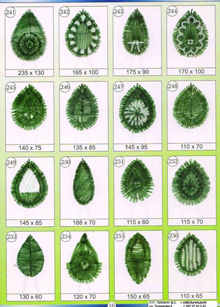 A Ukrainian florist advertises various designs for wreaths, most of them variations on the tear-drop form of the mandorla.
A Ukrainian florist advertises various designs for wreaths, most of them variations on the tear-drop form of the mandorla.
How different these sympathy arrangements are from the circular wreaths and sprays we’re accustomed to. All morning we’ve been searching for clues as to their distinctive shape. Egg? Seed? Womb? Teardrop?
After browsing through Russian and Ukrainian florists websites, we’re still not certain why this form of tribute is such a consistent floral presence at funerals in the region. We’ve read that even-numbered flowers are preferred (even required) at times of mourning and that yellow blooms are unwelcome at happy or sad occasions alike.
Having read up on Russian funeral customs and dipped into church symbolism, we’ve come to think that the massive oval-shaped arrangements follow an iconic shape in Eastern Orthodoxy—the mandorla.
This encapsulating form recurs in Christian imagery, a kind of radiant bubble that surrounds divine figures when they appear to humankind.
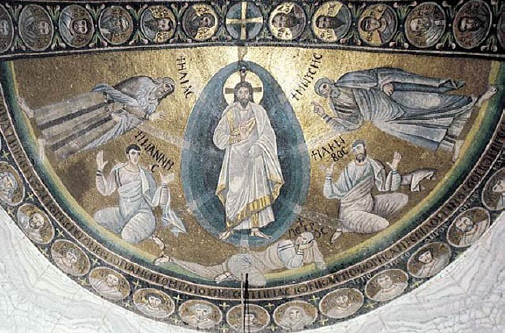
One of the earliest such images is this Apse mosaic of the Transfiguration, St. Catherine’s Monastery, Mount Sinai, c. 550-565
“The term refers to the almond like shape: “mandorla” means almond nut in Italian. In icons of the Eastern Orthodox Church, the mandorla is used to depict sacred moments which transcend time and space, such as the Resurrection, Transfiguration, and the Dormition of the Theotokos.”
In Pythagorean symbolism and pre-Christian art, the mandorla shape was conceived as two intersecting circles, alluding again to a kind of “eclipse,” when two different dimensions coalesce; momentarily, there’s a keyhole that makes it possible to see a more essential reality than we know in everyday life.
These pendulous wreaths, often fashioned with concentric rings of flower-color, remind us of the luminous cloud around our Lady of Guadalupe, a form that both protects and projects the power residing inside.
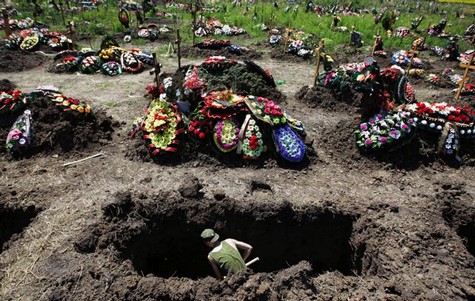
A soldier digs a grave outside Krymsk, Russia. More than 170 residents of the town died in early morning floods Sunday July 8.
Photo: Sergey Ponomarev, for AP
The intersection of opposites certainly comes through in Sergey Ponomarev’s astonishing photo from the Krymsk cemetery. A pale young man (or is it a girl?) shovels inside a grave, a black block surrounded with mud, while on the ground above scores of the bright egg-shaped arrangements lie across fresh gravemounds; all the way to the horizon, they shine back at the sky.
Friday, May 25, 2012
Monsieur Oscar’s Fast Food
From “Please, Don’t Eat the Daisies” to “Holy Motors,” devouring flowers takes on a sinister new flavor.
A wild image of French actor Denis Lavant is making the rounds this week. Have you seen it? Eyes crossed and bare chest exposed beneath his jacket, he is running down the street chomping a bundle of red daisies.
Lavant portrays an ogre known mysteriously (and wittily) as Monsieur Oscar in Holy Motors, a new film by Leos Carax that just screened to applause and boos at the Cannes Film Festival.
One critic explains, “Mr. Oscar advances through his list of jobs – an old beggar woman, an assassin, a businessman, a father, a dying old man, a deranged, violent monster who eats flowers and kidnaps supermodels.”
In this age of downsizing, Mr. O demonstrates admirable resilience and quite a lot of energy, a far more entrepreneurial route than our own jagged career path. The list of unremunerated occupations lengthens, but “assassin” presumably still pays well.
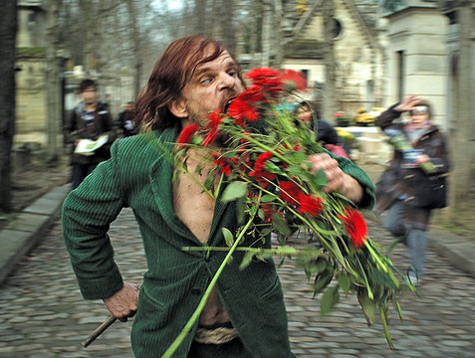
Denis Lavant as Monsieur Oscar in Holy Motors
Photo: Cannes Film Festival/European Pressphoto Agency
Friday, April 27, 2012
Seeduction
More luscious than Penthouse, seed catalogues of the late 19th Century were designed to sell, and to procreate.
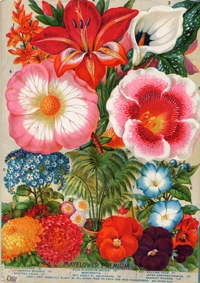 John Lewis Childs
John Lewis Childs
seed packet
Floral Park, NY 1897
Smithsonian Institution
You don’t have to have a trowel, or a yard, much less green fingers or familiarity with pH and hardiness zones to come home with a seed packet.
Dig around in any drawer around here and you’ll find sweet pea, zinnia, and even proteas packets from years gone by. We keep on hand an envelope of edelweiss seed a friend brought back from Germany years ago just…, well, just because.
Seed packets contain promise, especially for those of us who know little or nothing about viability. They’re the proto-triumph of potential, miniature bulwarks against future gloom and deprivation. Maybe that’s why repositories of them are called “banks.”
Art & Media • Culture & Society • Gardening & Landscape • Permalink
Wednesday, April 18, 2012
How We Used to Be
Talking back to the past, John Levett owns up to an inner Constance Spry. Let’s continue, John, whenever, however. For what’s gone before, all thanks.

Bench at Letchworth Garden City
“Toward the Smell of Progress” (8/14/07)
Essay and photos by John Levett
There was a long-serving picture editor at Time-Life whose name I can’t recall. He wrote well and remembered every picture he came across. One of his best pieces was about the numbers who regularly sent him their snaps and, almost as a matter of course, expected an off-the-cuff portfolio review. He was politeness itself in responding briefly to the submissions whilst wishing that he could bring to these responses words along the lines of: ‘You have a fine photograph of the Washington Monument but I would venture that it lacks two essential components. The first is Martin Luther King and the other is half a million people.’

